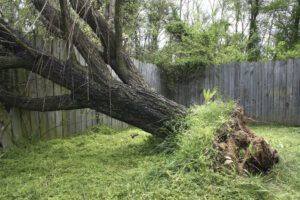When it comes to curb appeal, it’s more than just maintaining a beautiful lawn. Proper tree care is very necessary and can really enhance the overall look of your home’s exterior.

On the other hand, sometimes it is necessary to remove a tree for several reasons. It might have been damaged during a storm, it might be dying, causing damage to your foundation, or simply just neglected with falling branches causing damage to your property. More importantly, an unstable tree can be extremely dangerous to anyone near it, not to mention the risk of falling on your neighbor’s property.
DIY vs Professional Tree Cutting Services
Whatever the reason may be for possible tree removal, bringing in a professional tree removal service could be the only way to get the job done with the least amount of hassle.
Doing it yourself is always going to cost less upfront but always keep in mind that removing a tree can be dangerous even for the most enthusiastic DIYer.
In fact, arborists and tree surgeons have one of the most dangerous careers in the world. Regardless of all the safety measures takes alongside the necessary qualifications, around 200 die every year from tree removal accidents. This is why, when comparing estimates, be sure to check for up-to-date licensing and insurance.
So before you consider doing it yourself, consider the risks involved with climbing a tree and operating heavy equipment at the same time. It takes a level of experience to successfully remove any tree.
More importantly, a professional service may in some cases even be able to save the tree.
Understanding how much it might cost you is just as important, so be sure to come to terms with exactly what is required before you bring in a professional service to take care of your landscaping needs.
How Much Does It Cost To Remove Trees?
Before you can get to an accurate price on your tree removal costs, it’s important to remember that several factors can influence the overall cost.
Here are some of the factors that may affect your bottom line:
- DIY vs bringing in the professional
- your location
- size, number, and type of the trees
- the thickness of the branches
- replacement services
The average cost to remove a tree ranges anywhere from $150 on the low to as much as $1,500+ depending on several factors.
Equally, stump removal is a separate service for most professional tree removal companies. and can add anywhere from $60 to as high as $1,000 for stump grinding.
If you insist on doing it yourself, here are some additional costs to consider:
- Heavy-duty gas tree trimmer rental: $48-$52+ per day
- Hand-held pruners and loppers: $30-$55
- Safety equipment: $50-$150
- Gas pole pruner: $150-$325
- Dumping fees: $25-$100
Many tree removal services operate 24 hours a day, and local professionals also keep a fleet of specialized vehicles ready. The costs will vary. It is highly recommended that you compare several quotes from professionals in your area to remove trees on your property.
What Happens When a Tree Falls in my Neighbor’s Yard?
It may come as a surprise, but when your neighbor’s tree falls and damages your property, you may still be out of pocket – even though it’s not your tree. Of course, whichever side of the property line the trunk stands on establishes the rightful owner.
However, once it falls, reasonable negligence will play a factor in determining liability. Local tree removal experts may in some cases even be able to settle the dispute faster than the local authorities.
Nevertheless, always keep in mind that, even when a tree is not on your property, you still have a responsibility to alert the owner of possible dangers.

When a tree does fall and breaches onto your property, the tree will (in most cases) be where it crosses over onto the other side.
Whatever is on your side of the fence is your responsibility. A land surveyor can determine the exact boundary line between two properties as well as iron pipes embedded into the ground to work out who is responsible for which portion of tree removal.
However, reasonable negligence will play a factor in determining liability after a tree falls should a dispute arise.
For example, if the tree owner ignores visible signs of deterioration, you still have the responsibility to prove that you made reasonable efforts to alert the owner of the problem in order to remedy the situation. Some form of written communication between you and your neighbor will assist in case of a dispute arising. On the other hand, if a well-maintained tree falls due to extreme weather (such as a tornado), it will be considered an “act of God”.
